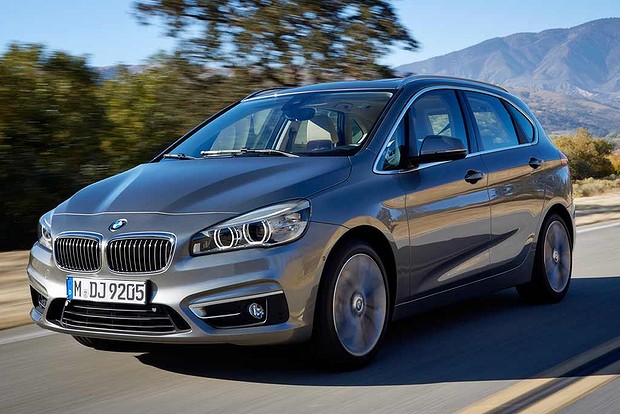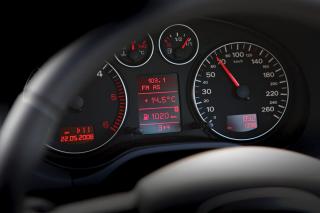 Click for more photos
Click for more photos
BMW 2-Series Active Tourer
BMW 2-Series Active Tourer.
The spiel behind BMW’s first front-wheel drive model – the 2-Series Active Tourer - reads a lot like a modern political manifesto: full of clever PR spin and promising a revolution.
After years of arguing that competitor offerings were largely inferior to its own brand of sportier rear-drive underpinnings – Audi and Mercedes-Benz have utilised front-drive layouts for more than a decade – BMW now concedes there is merit in front-wheel drive applications, namely in cost savings and added functionality.
It’s fair to say the new model represents a shift in thinking for the storied German car maker, and a concession that perhaps its competitors were on the right track all along… Tellingly, the new 2-Series Active Tourer will be the first of up to 12 such front-drive BMW models before decade’s end.
“To bring this car to market we realised we needed a front-wheel drive,” admits one of the Active Tourer’s main hands, Martin Schuster. “We had no offer in this segment, and we wanted new customers.”
Three variants of the Active Tourer will be offered in Australia: the three-cylinder 218i base car ($44,400), diesel-powered 218d ($47,800) and flagship 225i ($54,900).
Withstanding the obvious interest around its front-wheel drive underpinnings, the Active Tourer neither over-excited or under whelmed during its international launch in Austria this week.
From a distance, the outside impression is of a dumpy and awkward people mover, with a perched up seating position and very little in the way of driving engagement.
The exterior shape certainly errs on the conservative side of things, but sliding into the driver’s seat largely discredited many other misconceptions. The interior feels well put together, with bolstered and supportive seats in all variants, soft-to-touch materials in the dashboard and contact points, and a centre cluster and door pockets that are functional and yet nice to look at. The centre fascia is perhaps a little more aesthetically pleasing than other recent BMW models, with a tablet-style screen sitting atop a mix of shiny faux-timber or piano black inlays, stitched leather and ample storage compartments. A centrally-mounted dynamic toggle in the dashboard facilitates use of the three different driving modes – Sport, Comfort and EcoPro – while a nearby rotary dial navigates the different menu options.
Upon closer inspection there are signs of cost-cutting, with low-rent plastics in the out-of-sight areas and a flip-up head-up display system that, like others, isn’t compatible with polarised sun glasses.
Not surprisingly, the Active Tourer’s biggest redeeming feature is functionality. A 468-litre boot is accessed via an automatic tail gate, the 40:20:40 split-fold seats are retracted flat with the help of quick release levers and the rear floor is mostly flat due to the absence of rear-drive architecture. Six-foot passengers would have no troubles occupying the outside rear chairs for a couple of hours at a time, with good leg room, shoulder and head room, as well as rear air vents.
On the road, the large glasshouse and high ride position endows the Active Tourer with a commanding position over the road. Vision is generally good, with the only real bug bear being a bulky triangular A-pillar which tends to impede the forward outlook on busy intersections or tight corners.
The front-drive layout appeases inside needs and, to a large extent, offers the same ability in a driving sense. There’s no point sugar-coating it; if you’re after a wholly engaging drive, there are any number of rear-drive BMWs that will fulfil that brief better than this newcomer.
But the Active Tourer is entertaining enough for a vehicle that is geared more towards comfort than performance. The steering offers a convincing amount of weight and accuracy, there’s a nice amount of tractability through corners and the body control is admirable for the high-riding profile.
With almost 60 per cent of its weight over the front axles, understeer – when the front wheels push wide – is easily provoked. Similarly, getting the front wheels to scramble for grip is simply a matter of flexing the right foot with a hint of enthusiasm.
The comfort-oriented tuning of the suspension translates to a ride which relays surface imperfections without being crashy or jittery, on both 16-inch and 17-inch wheels. We won’t be able to fully ascertain the ride quality until the vehicle reaches local showrooms, where it will most likely be fitted with run-flat tyres instead of the conventional Pirelli P-Zeros our test vehicles were shod with.
We drove both the flagship 225i and the 218d at the international launch.
The former is probably the pick of the two, with a broad, flexible engine well matched to its eight-speed gearbox. The 2.0-litre four-cylinder engine produces 170kW and 350Nm, offering respectable performance (0-100km/h in 6.6 seconds) when needed along with an appealing engine note during headier applications. Peak values are met at 5000rpm and 1250rpm respectively, meaning the automatic is eager to keep it in the sweet spot at times. The teaming proved fairly efficient during our time with the vehicle, returning a combined reading of 8.6L/100km.
On wet roads, the 225i threatens to spin through the front wheels when really provoked, however we’re yet to drive it on dry bitumen.
The diesel-powered 218d helps address some of those deficiencies by better laying down its 110kW of power and 330Nm of torque. Matched to a six-speed manual transmission, it proves the most efficient on the road, sitting marginally above its 4.2L/100km claimed.
The diesel mill is less refined than the petrol, with a gruff idle and a narrower rev band. Shifts from the six-speed manual are surprisingly notchy though this is mostly irrelevant for Australia, where only an eight-speed automatic will be offered.
We’ll reserve judgement on the third variant due for Australia, the three-cylinder 218i, as it wasn’t available at launch. If the recent Mini Cooper – with which it shares its engine – is any indication, it will be a compelling base model car.
The Active Tourer is poised to come with a strong selling pitch when it reaches Australia. The standard specification on local models includes automatic transmission, reversing camera, front and rear parking sensors, park assist, satellite navigation, stop-start function, automatic tail gate and BMW Driver Assistant including forward collision warning with autonomous braking and lane departure warning.
While questions over the authenticity of the Active Tourer are warranted, they’re not likely to rate a mention among the hordes of price and badge-conscious buyers poised to snap up the newcomer when it lands in November.
The Active Tourer doesn’t amount to the big revolution being spruiked by BMW. However it is impressive nonetheless, even if it did show up to the party a little late.
Why front-wheel drive?
Is this a case of cost-saving gone mad or is there a genuine reason for BMW’s sudden adoption of front-wheel drive architecture?
According to one of the masterminds of the 2-SeriesActive Tourer, it’s a bit of both.
“When we started we wanted a concept car with space and a high conquest rate,” development head Martin Schuster said this week.
“To bring this car to market we realised we needed a front-wheel-drive. Sure, we had a discussion which kind of car would be the outcome with rear-wheel drive, but we saw very, very fast that it makes no sense.
“You say ok, do we need this concept, and first was I to be honest: BMW and front-drive, how does this work? Like you said we are very proud of rear-wheel drive, sure, but more and more you say what can we do with FWD architecture, and we know from Mini we can make it work.”
BMW 2-Series Active Tourer pricing and specifications
On sale: November
Price: $44,440-$54,900 plus on-road costs
Engine: 1.5-litre three-cylinder petrol/2.0 litre- four-cylinder diesel/ 2.0-litre four-cylinder petrol
Transmission: Six-speed automatic/Eight-speed automatic, FWD
Power: 100kW/110kW/170kW
Torque: 220Nm/330Nm/350Nm
Fuel use: 5.2L/100km/4.2L/100km/6.1L/100km















































18 comments so far
More comments
New user? Sign up
Make a comment
You are logged in as [Logout]
All information entered below may be published.
Thank you
Your comment has been submitted for approval.
Comments are moderated and are generally published if they are on-topic and not abusive.